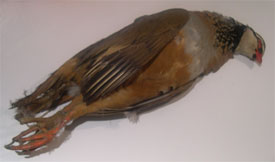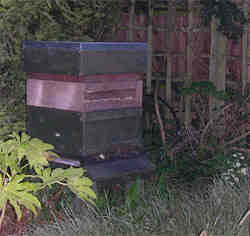How to pluck and draw game: a partridge or pheasant.
Posted by Fiona Nevile in Basics, Pheasant and Game | 80 comments Game is a treat. We don’t shoot and I don’t know many people who do. Hero of the kitchen garden, John Coe, is a beater during the winter months and sometimes brings us a brace of pheasant. His presents are always hung and dressed, ready for the pot.
Game is a treat. We don’t shoot and I don’t know many people who do. Hero of the kitchen garden, John Coe, is a beater during the winter months and sometimes brings us a brace of pheasant. His presents are always hung and dressed, ready for the pot.
Occasionally we’re given a brace of pheasant or partridge, complete with feathers Until today, I have hung, skinned and drawn them, and then cooked them slowly, enclosed in a casserole. Now I know how to pluck a bird. By keeping the skin our repertoire of recipes has increased tenfold. The skin contains fat and makes for a more succulent bird. Roasting is now a possible option.
I’m working at a lovely house in Upend at the moment. Yesterday Carol and Patrick gave me a brace of partridge. I was delighted and spent a happy split second planning how to cook them. As I skin my game the Romanian way, there is only one recipe that really suits game prepared in this way. It’s mouth watering and will appear on this blog after Christmas. Update: 27 January 2007, we have now developed two more exellent recipes for skinned game. Check out the recipes section of the blog.
I was always a bit envious of people who could pluck game, imagining it to be a complex and fiddly procedure. Today I discovered that it’s not. When Patrick found out that I didn’t know how to pluck a bird he immediately volunteered to give me a lesson. He rustled up a carrier bag; I grabbed the birds they had given me. Patrick demonstrated and within minutes I was plucking my first bird. The plucking is straightforward. Dealing with fluttering feathers is not. Hence the carrier bag.
How to hang, pluck and draw a partridge or pheasant
- Hang the bird for a couple of days (by the neck) in a cool place such as a garage or cold larder.
- Cut off the head at the base of the neck with a decent pair of scissors. (Once you have got rid of this the whole procedure seems less ghoulish).
- snap the lower legs at the joints and pull out the tendons. This takes some strength.
- Cut off the wings at the joint. (you will find this in the fold between the wing and the body.)
Plucking the feathers:
It is easier to pluck a bird when it is warm. Let a bird reach room temperature before plucking, it makes an enormous difference
- Find a carrier bag (any supermarket one will do)
- Stand your carrier bag on a table, workbench, or in the sink (I use the sink) the bird will be plucked into this. Pull up the sides of the carrier bag so that you have an enclosed area in which to contain the plucked feathers.
- Put a few sheets of newspaper around your working area to catch any stray feathers.
- Hold the bird by the legs and brush the feathers on the breast and back (against the grain, so to speak) so they sit up a little. With small neat movements pluck the feathers away and down from the bird, ideally straight into the carrier bag.
If skin comes away on the base of the feathers you are being too rough or trying to remove too many feathers at once. Experiment a little with this. You will soon get the feel of the most efficient plucking movement. I place my fingers on the skin around the plucking area.this stops the skin being plucked from the carcass along with the tips of the feathers. - Spread the tail feathers into a fan shape and pluck these following the line of the feather.
- To remove the leg feathers, hold the body and brush the feathers smooth (with the grain) and pluck them sharply down in that direction.
Another friend sits down to pluck a bird, with a dustbin liner between her knees. The feathers are plucked with a short downwards movement, straight into the bag. It’s worth experimenting with different plucking methods to find one that suits you best. I find that some feathers are more easily removed ‘against the grain’ and some ‘with the grain’. The secret is in the short precise plucking movement. If you can get into a relaxed rythm it’s easy.
Drawing the bird
- Remove the crop (from the head end) by gently putting a finger into the neck opening, rotating gently and pulling the crop out. If you are curious, you can open this to see what the last meal was. Remove the gullet and windpipe.
- Now stick your forefinger up the birds bum. Rotate it gently and draw out the liver and guts. We freeze the livers to use in an excellent terrine.
- Wash the bird (inside and out) and refrigerate for a couple of days before use.
If your bird smalls bad chuck it away, contained in a couple of tightly sealed carrier bags. Sometimes gun dogs will pick up a lost bird from a day or so before. This is rare but it has happened to us.
Skinning a bird:
Follow the steps for ‘How to hang, pluck and draw a partridge or pheasant’ then put your finger under the skin around the neck and loosen the skin. Hold the skin firmly and pull gently down towards the tail. The skin and feathers should come off in one piece. Once skinned, don’t forget to draw the bird (see above). Roasting is really out if you have skinned your bird but any casserole or recipe that encloses the bird will probably be sucessful. See our pheasant recipes, these were all cooked with skinned game and are excellent.
Leave a reply






Hi Rod
Some friends of mine have a pheasant plucking machine and it’s amazing. Thanks for dropping by and pointing out the videos on YouTube.
I just checked and there are numerous video clips on you tube Delta Waterfowl…..instructions for Plucking ducks, Cleaning(drawing) both by Plucking and breasting (which should be against the law) moost people that take the breast take it and thro away the legs and the thighs, the best parts…………so here it is if you would like to post up and let you readers VIEW some YANKEES HAVE A GO AT IT Thanks Again, ROD
I make up and sell over the internet, custom made duck pluckers which I recently tried out on pheasants(scalded worked best) but on my site I have plucker reviews from various gents that have plucked partrige, chuckar and you can watch me as I pluck a duck in my living room!! I will try to find a Delta Waterfowl u tube video of plucking AND gutting a duck Thank You, ROD
http://www.pluckwitheasypluck.com
Hi – I have been given two ducks (mallard, drake) with feathers. I have read on other sites that you should/shouldn’t hang ducks but clean them immediately and remove the wax gland? I have had them stored in a cold shed for 3 days does anybody have any advice?
Thanks
Hi Margaret
I’m sorry but I have no experience with duck 🙁
Hi fn. Just what I’ve been looking for. Are you saying there’s no need to bleed a duck? Advice appreciated.
hello, ive been given a brace of pheasant which where shot on saturday. will it be ok to pluck and draw them on friday or is that leaving them to long?thanks, danny
Hi Danny
I usually hang them for three days – sometimes four if it’s very cold. Six days is quite a long time. If it was me I’d put them in the fridge now. Remember to let them get up to room temperature before plucking.
Hello t’capt’n
Forget the wax. Those downy feathers come off easily. Give yourself a bit of extra time and relax. Plucking a duck should be straight forward.
Hi Fantastic site. Other sites recommend using wax to finish off the small feathers on a duck. Is this really necessary? And if so which type of wax? I’m a chef but never used unplucked game before (city boy)
and my mates just asked me over to prepare a dinner with one. Don’t want to skin it as it will leave me with a lot less recipes. Thanks. Bill
Thanks for the advice – I have twenty chukar partridge that should start feeling nervous!I regularly get pheasant from my mates shoot but up to now I have always ripped the skin when plucking, I note you say partridge should be easier, I will let you know.